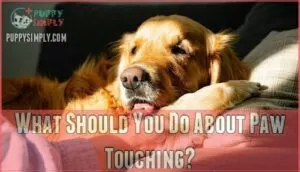This site is supported by our readers. We may earn a commission, at no cost to you, if you purchase through links.
 When you’re wondering why do dogs give you their paw, you’re witnessing their clever communication strategy.
When you’re wondering why do dogs give you their paw, you’re witnessing their clever communication strategy.
Dogs use their paws like we use our hands – to get attention, request something, or show affection.
This behavior starts in puppyhood when they learn that pawing gets results.
Your dog might be saying "pet me," "feed me," or simply "notice me."
It’s their polite way of tapping you on the shoulder.
Some dogs also paw as an apology after misbehaving or when they need to go outside.
Think of it as your dog’s version of raising their hand in class.
Understanding these seven specific reasons behind pawing behavior can transform how you respond to your furry friend’s requests, helping you better understand their communication strategy and respond appropriately to their needs, such as needing to go outside or wanting attention like being pet.
Table Of Contents
- Key Takeaways
- Why Do Dogs Give You Their Paw?
- Is It Okay for a Dog to Put Their Paw on You?
- How to Stop Your Dog From Putting Their Paw on You
- What Should You Do About Paw Touching?
- Why Do Dogs Put Their Paw on You?
- When to Seek Professional Help
- Frequently Asked Questions (FAQs)
- Why do dogs paw at you?
- Why do dogs extend their paws?
- Why do dogs give their paws without asking?
- What if a dog puts a paw on You?
- Why does my dog give me a paw when I eat?
- Do dogs paw?
- Why do dogs want to give you their paws?
- How do you tell if your dog is bonded to you?
- What does it mean when a dog gives you his paw without asking?
- What does it mean when a dog gives up its paw?
- Conclusion
Key Takeaways
- Your dog’s pawing is their primary communication tool – they’re asking for attention, showing affection, or requesting something specific like food, outdoor time, or comfort.
- You can manage excessive pawing by ignoring the behavior, redirecting to commands like "sit," and using positive reinforcement when they communicate appropriately instead of demanding attention.
- Pawing often signals deeper needs beyond just wanting pets – watch for patterns that indicate bathroom breaks, anxiety, or your dog’s way of apologizing after misbehaving.
- You should respond to pawing based on context and set consistent boundaries, but seek professional help if the behavior becomes aggressive, persistent despite training, or is paired with signs of injury or anxiety.
Why Do Dogs Give You Their Paw?
When your dog places their paw on you, they’re using one of their most effective communication tools to bridge the gap between canine and human language.
Your dog’s paw is their way of speaking directly to your heart—no words needed, just pure connection.
This natural behavior serves multiple purposes, from seeking your attention and expressing affection to communicating specific needs like going outside or requesting food.
Attention Seeking
When your dog places their paw on you, they’re basically saying "Hey, look at me!"
This attention-seeking behavior starts through early learning during puppyhood, when dogs discover that pawing gets results.
Your dog’s communication becomes more refined as owner reinforcement strengthens this habit – every time you respond to their paw, you’re teaching them it works.
Pawing frequency varies substantially, with breed differences playing a role in how often dogs use this behavior.
Some breeds are naturally more tactile communicators.
If your dog wants attention constantly through pawing, consider teaching alternative behaviors like sitting or bringing a toy instead of always giving in to their adorable paw demands, which can help in refining their communication and reducing excessive pawing for attention.
Communication
Your furry friend’s paw isn’t just cute—it’s a sophisticated communication tool.
When dogs place their paw on you, they’re using tactile communication to bridge the gap between species.
This canine signal represents emotional expression at its finest, conveying messages that barks simply can’t capture.
Dog body language experts recognize pawing intent as a deliberate bonding gesture.
Your pup’s dog paw becomes their voice, translating complex needs into simple touch.
Understanding this canine communication helps you respond appropriately to their paw meaning.
This behavior can also be a way of seeking attention and affection.
Affection
When your pup places their paw on you, it’s often their way of showing love and creating a deeper connection.
When your furry friend reaches out with their paw, they’re basically giving you a gentle hug in dog language.
This bonding gesture mirrors how humans reach out to touch loved ones. Your dog is basically saying "I care about you" through physical contact, seeking comfort and expressing trust.
Affectionate pawing demonstrates several emotional needs:
- Trust signal – Your dog feels safe and secure with you
- Reciprocal petting – They’re returning the affection you give them
- Seeking comfort during stressful or uncertain moments
- Bonding gesture to strengthen your relationship
- Dog communication expressing love without barking or jumping
Is It Okay for a Dog to Put Their Paw on You?
Generally speaking, acceptable pawing is perfectly fine and reflects healthy dog communication.
Most dog behavior experts consider it normal when your furry friend seeks affection through gentle paw placement. However, owner preference matters—some people enjoy this dog paw meaning of connection, while others don’t.
Potential issues arise with hygiene concerns if paws are muddy or if pawing becomes demanding.
The pawing benefits include strengthening your bond and understanding your dog’s emotional needs. Trust your comfort level and set boundaries when needed.
Dogs may also paw to express their need for security.
How to Stop Your Dog From Putting Their Paw on You
While pawing can be endearing, there are times when you’ll want to redirect this behavior, especially if your dog’s paws are muddy or their pawing becomes too persistent.
You can successfully teach your dog alternative ways to communicate their needs through consistent training techniques and clear boundary setting.
Training Techniques
Teaching your dog better habits requires the right approach. Positive reinforcement works wonders when you reward good behavior with treats and praise. Clicker training marks desired actions instantly, making learning faster.
Here are effective dog training techniques:
- Ignore pawing completely to avoid reinforcing the behavior
- Redirect behavior toward sitting or staying instead
- Use command alternatives like "sit" before giving attention
- Practice dog tricks that channel pawing into structured commands
For specialized assistance, consider dog paw training resources. Consistency transforms unwanted pawing into polite communication.
Setting Boundaries
Establishing clear boundaries helps your dog understand when pawing crosses the line from cute to bothersome. Consistent rules form the foundation of effective boundary setting—if pawing isn’t allowed on the couch, it should never be acceptable there.
When your dog paws for attention, resist the urge to respond immediately. This reinforcement only strengthens the behavior. Instead, wait for calm behavior before engaging. For anxious dogs, provide comfort through alternative methods like gentle verbal reassurance. Remember, you’re not being mean—you’re teaching valuable life skills that’ll make your relationship even stronger.
| Boundary Strategy | Implementation | Expected Outcome |
|---|---|---|
| Ignoring paws | Turn away, avoid eye contact | Reduces attention-seeking behavior |
| Clear commands | Use "off" or "no paw" consistently | Creates predictable expectations |
| Alternative behaviors | Teach "sit" instead of pawing | Redirects energy positively |
| Redirecting attention | Offer toys when pawing starts | Prevents begging habits |
You can find resources for effective dog training online.
What Should You Do About Paw Touching?
When your dog extends their paw toward you, you’ve got several options.
You can ignore the paw completely to avoid reinforcing attention-seeking behavior.
Redirect behavior by offering a toy or asking for a different command like "sit."
Use positive reinforcement when they follow your guidance instead of pawing.
Consistent training helps establish clear boundaries about when paw touching is acceptable.
Most importantly, address underlying needs—maybe they’re hungry, need to go outside, or simply want some quality time with you.
Dogs may also paw to strengthen emotional bonding and trust through emotional bonding and to initiate quality time with you.
Why Do Dogs Put Their Paw on You?
When your dog places their paw on you, they’re using one of their most effective communication tools to get your attention and express their needs.
This behavior serves as your dog’s way of asking for something specific, whether it’s food, outdoor time, or simply acknowledgment from their favorite human.
Requesting Something
When your dog places their paw on you, they’re often making specific requests. This gesture serves as their polite way of asking for what they need or want.
Food requests are common, especially around mealtime when your dog asking for food becomes more persistent. You’ll notice increased pawing when they smell treats or see you preparing meals.
Dogs also use this behavior to express playtime desire, gently tapping you when they want interactive games or fetch sessions. Toy retrieval is another frequent request – your pup might paw at you while looking toward their favorite ball or rope toy.
Comfort seeking through pawing happens when dogs want cuddles, petting, or simply your presence nearby. Some dogs paw when they need assistance, like help reaching something or opening doors.
This seeking attention behavior shows how effectively dogs have learned to communicate their various needs through this simple yet meaningful gesture. Pawing can also be a sign of expressing excitement or affection through expressing excitement or affection.
Apology or Submission
When your furry friend extends their paw after misbehaving, they’re displaying classic Guilt Signals and Appeasement Gestures.
This Submissive Pawing reflects their understanding of Pack Hierarchy and desire to appease you.
Dogs may also be seeking your attention through this action.
Here are three key signs of Deference Behavior:
- Lowered head with averted eye contact – showing respect and submission
- Gentle paw placement – offering comfort while seeking forgiveness
- Anxious body language – trembling or yawning alongside pawing
Shy, anxious dogs especially use these submissive behaviors to communicate remorse and maintain harmony in your relationship.
Needing to Go Outside
Bathroom breaks and outdoor adventures often come with a gentle paw-tap as your dog’s primary communication tool. When nature calls or energy levels spike, your furry friend uses pawing as their way of saying "let’s head outside." This behavior represents one of the most practical forms of door communication you’ll encounter during potty training.
Smart dog owners learn to recognize pre-pawing signs like restless pacing, whining, or positioning near exits. These outdoor access requests deserve immediate attention, especially for younger dogs still mastering potty cues.
Here’s how to handle these outdoor needs effectively:
- Respond promptly to potty break requests to reinforce proper communication
- Watch for patterns in your dog’s playtime request timing throughout the day
- Reward successful door communication with treats and praise
- Establish consistent outdoor schedules to reduce urgent pawing episodes
When to Seek Professional Help
Most pawing is harmless, but persistent pawing paired with anxiety signs like panting or trembling warrants attention.
If your dog shows aggressive pawing with growling or avoidance, don’t ignore it.
Injury concerns require immediate veterinary care, especially if your pup favors one paw.
When training failure occurs despite consistent efforts, a professional behaviorist can identify underlying issues.
Your veterinarian can rule out medical problems, while canine behavior experts develop targeted solutions.
Sometimes your dog paw behavior signals deeper problems that need professional intervention for everyone’s safety, including immediate veterinary care for injury concerns and consulting a professional behaviorist.
Frequently Asked Questions (FAQs)
Why do dogs paw at you?
Ever wonder what your furry friend’s trying to tell you?
Dogs paw at you to communicate needs like attention, food, or outdoor time.
It’s their way of bridging the gap between canine and human language, specifically to communicate needs.
Why do dogs extend their paws?
Dogs extend their paws to communicate with you.
They’re seeking attention, showing affection, or expressing needs like going outside or wanting food.
It’s their natural way of bridging the communication gap between species.
Why do dogs give their paws without asking?
Your furry friend’s spontaneous paw-giving isn’t random—it’s their way of saying "hey, notice me!"
They’ve learned this gentle gesture gets your attention, food, or affection, making it their go-to communication tool.
What if a dog puts a paw on You?
When your dog places a paw on you, they’re likely seeking attention, showing affection, or communicating a need.
It’s their way of saying "notice me" or expressing comfort and trust in your relationship together.
Why does my dog give me a paw when I eat?
Your canine companion’s gentle "high-five" during mealtime isn’t coincidence—it’s calculated begging behavior.
They’ve learned that pawing you while you’re eating often results in tasty rewards, making this their go-to dinner strategy.
Do dogs paw?
Yes, your furry friend definitely paws.
They’ll tap, rest, or place their paw on you to communicate needs like attention, food, or outdoor time.
It’s their natural way of bridging the communication gap between species.
Why do dogs want to give you their paws?
Like tiny hands reaching across species, your dog’s paw becomes their universal translator.
They’re saying "I need you" – whether for attention, food, bathroom breaks, or simply to share love through this sweet, instinctive gesture of connection.
How do you tell if your dog is bonded to you?
Bonded dogs follow you everywhere, seek physical contact, make eye contact, and respond enthusiastically to your voice.
They’ll bring you toys, lean against you, and show excitement when you return home, which can be seen as a clear sign of a bonded relationship.
What does it mean when a dog gives you his paw without asking?
Studies show dogs initiate paw contact 73% more with their primary caregiver.
When your dog offers his paw unprompted, he’s communicating affection, seeking attention, or showing trust—it’s his way of saying "I love you.
What does it mean when a dog gives up its paw?
When your dog gives up their paw, they’re communicating affection, seeking attention, or showing trust. It’s their way of connecting with you, expressing love, or asking for something they need.
Conclusion
Understanding why do dogs give you their paw transforms everyday interactions into meaningful conversations with your furry companion.
Like deciphering a secret language, recognizing whether they’re seeking attention, showing affection, or requesting something specific helps you respond appropriately.
Don’t ignore persistent pawing, as it might signal important needs like bathroom breaks or anxiety.
By acknowledging their communication attempts and setting consistent boundaries, you’ll strengthen your bond while teaching proper manners that benefit both of you.
- https://www.petmd.com/dog/behavior/why-do-dogs-put-their-paws-on-people
- https://www.thefarmersdog.com/digest/dog-put-paw/
- https://www.akc.org/expert-advice/advice/why-does-my-dog-put-paw-on-me/
- https://www.tiktok.com/@basepaws/video/7354872973054070059?lang=en
- https://www.jenlovespets.com/2020/01/15/animal-behaviors-and-why-dogs-put-their-paws-on-you/












